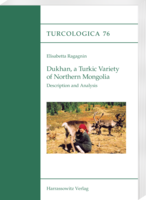|
|
more titles of the subject:
Download:
Please note: With adding digital Products to your cart
the payment will be handled via PayPal. The download will be provided after the payment is confirmed. This volume offers the first grammatical description of Dukhan, a highly endangered non-written Turkic language spoken in northern Mongolia by approximately 500 people. Most of the Dukhans are engaged in reindeer breeding and follow a nomadic lifestyle in the forested taiga areas of the Tsagaan Nuur county in the Khövsgöl province of Mongolia. The present description is exclusively based on the material collected by the author during intensive fieldwork sojourns. After a presentation of the Dukhan people with respect to
lifestyle, material culture and ethnohistorical background and some introductory linguistic considerations including a sociolinguistic scrutiny, the descriptive chapters focus on the sound system, derivational and infl ectional morphology and the verbal categories aspect, mood and tense. The description of the phonological system is of particular interest, since it helps to better understand the fortis vs. lenis opposition of Turkic consonants. The volume also includes a large text corpus organized according to the topics "How to do things", "Life stories", "Tales" and "Legends". Each text is interlinearized: the first line represents the phonetic IPA-based transcription, the second line represents the broad transcription in use in Turcological studies, whereas the third and last line contains morpheme-by-morpheme glosses. Translations are given separately at the end of each text. |
|||||||||||||||||||||||||||||||||||||||






